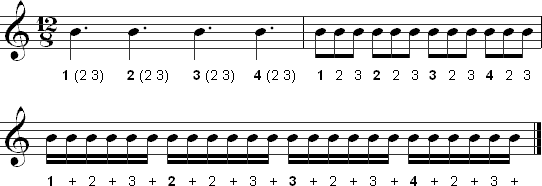

" For example, a sixteenth note quintuplet is indicated with the ratio 5:4, which can be read as, "five in the space of four." This means that there are five sixteenth notes in the space of four sixteenth notes.

An easy way to figure out tuplets with a ratio is to say " in the space of. The second number specifies the duration of the tuplet or how many notes of a certain value the first number replaces. The first number indicates how many notes are in the tuplet. Tuplets are notated in several ways: Number Number and a Bracket Ratio Subdividing the beat into 3, 5, 7 or other numbers produces a tuplet. For example, a quarter note in 4/4 time can be subdivided into 2, 4, 8, and so on. Tuplets are rhythms where a beat is subdivided into smaller note values other than the normal subdivision. Note values beyond thirty-second notes are possible, but don't occur very often. Open notehead with a stem, equal to 1/2 of a whole noteįilled-in notehead with a stem, equal to 1/4 of a whole noteįilled-in notehead with a stem and a single beam or flag, equal to 1/8 of a whole noteįilled-in notehead with a stem and two flags or beams, equal to 1/32 of a whole noteįilled-in notehead with a stem and three flags or beams Each dot after the first one increases the value of the note by half the value of the previous dot.ĭots beyond a single dot are rare, but occur frequently enough that it is worth knowing how they work. It is possible to have multiple dots on a single note. Note is two beats, a dot would increase the note value by one for a total of three beats. They increase the value of the note by half. Dotsĭots appear to the right of a notehead. It is possible for a group of notes to have multiple beams depending on the rhythm. The beams simplify the grouping of rhythms into units called beats. That could otherwise be notated with flags. Beams are used in place of flags when groups notes occur A note can have multiple flags if the noteĪ beam is a horizontal line that connects two or more notes. Flagįlags are attached to the end of the stem on the right side of the line. Note that this is a general rule and the stem direction will depend on other factors, such as the stem direction of other notes in a group of notes and clarity in music with multiple voices. If the note is below the third line, the stem will point up and is placed on right side of the notehead. If the note is on or above the third line of the staff, the stem points down and is on the left side of the note. The stem can be on the right or left side of the note and can point up or down. StemĪ vertical line attached to the notehead. Percussive techniques (pick scrapes, muted strings, etc.) are usually indicated with an 'X' notehead. Diamondsĭiamond noteheads are often used to indicate harmonics. Open diamonds or slanted box-shaped noteheads are used with the slashes to indicate certain rhythms. This is often used for notating strumming patterns. Several other kinds of noteheads are commonly used in guitar music. The notehead is the oval shaped part of a note. Notes have several parts: Notehead Oval-shaped Noteheads Each note has certain characteristics that indicate the rhythmic value of that note. Rhythms in music are notated with various kinds of notes. Rhythm and Time Signatures Parts of a Note


 0 kommentar(er)
0 kommentar(er)
